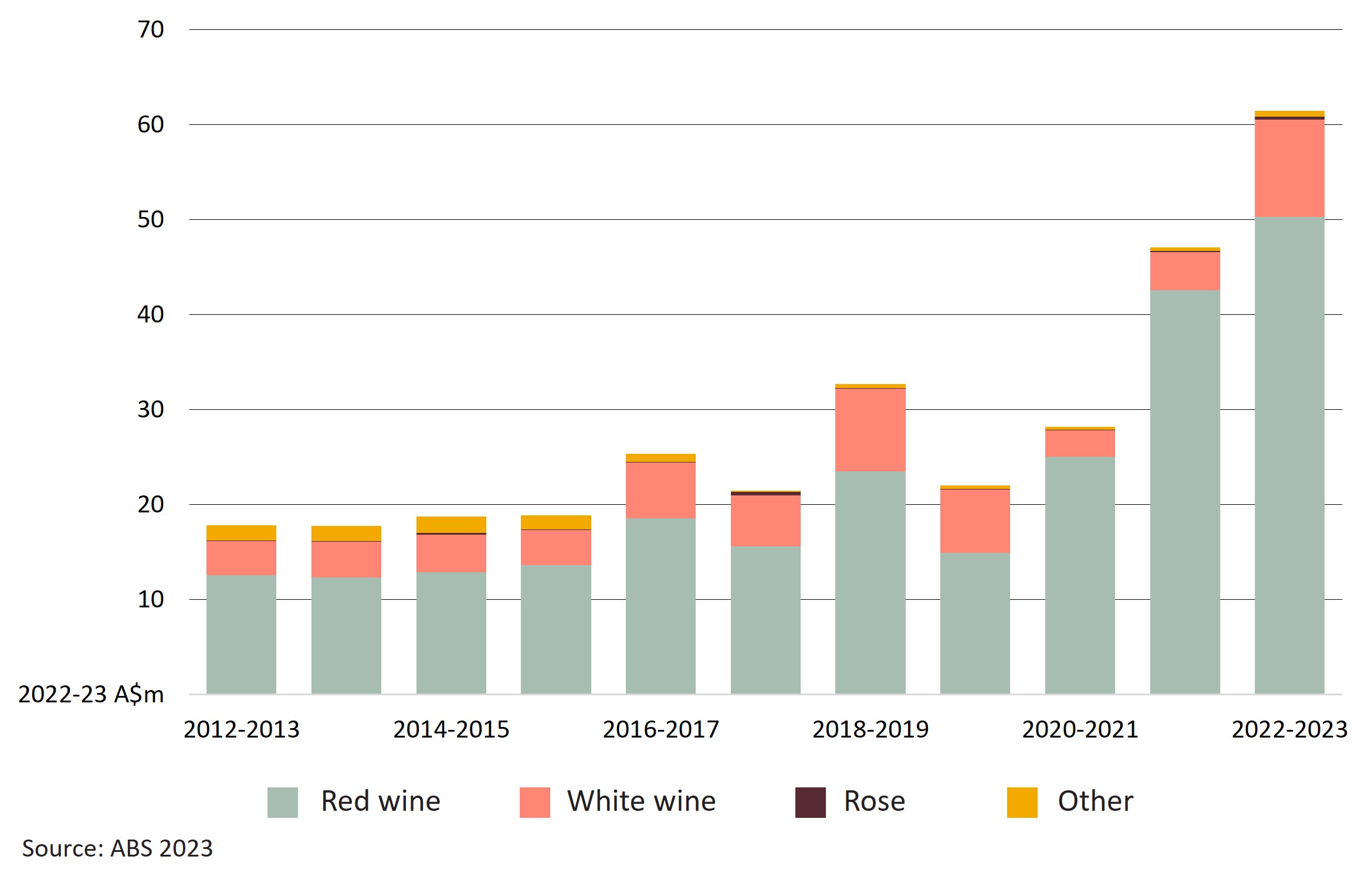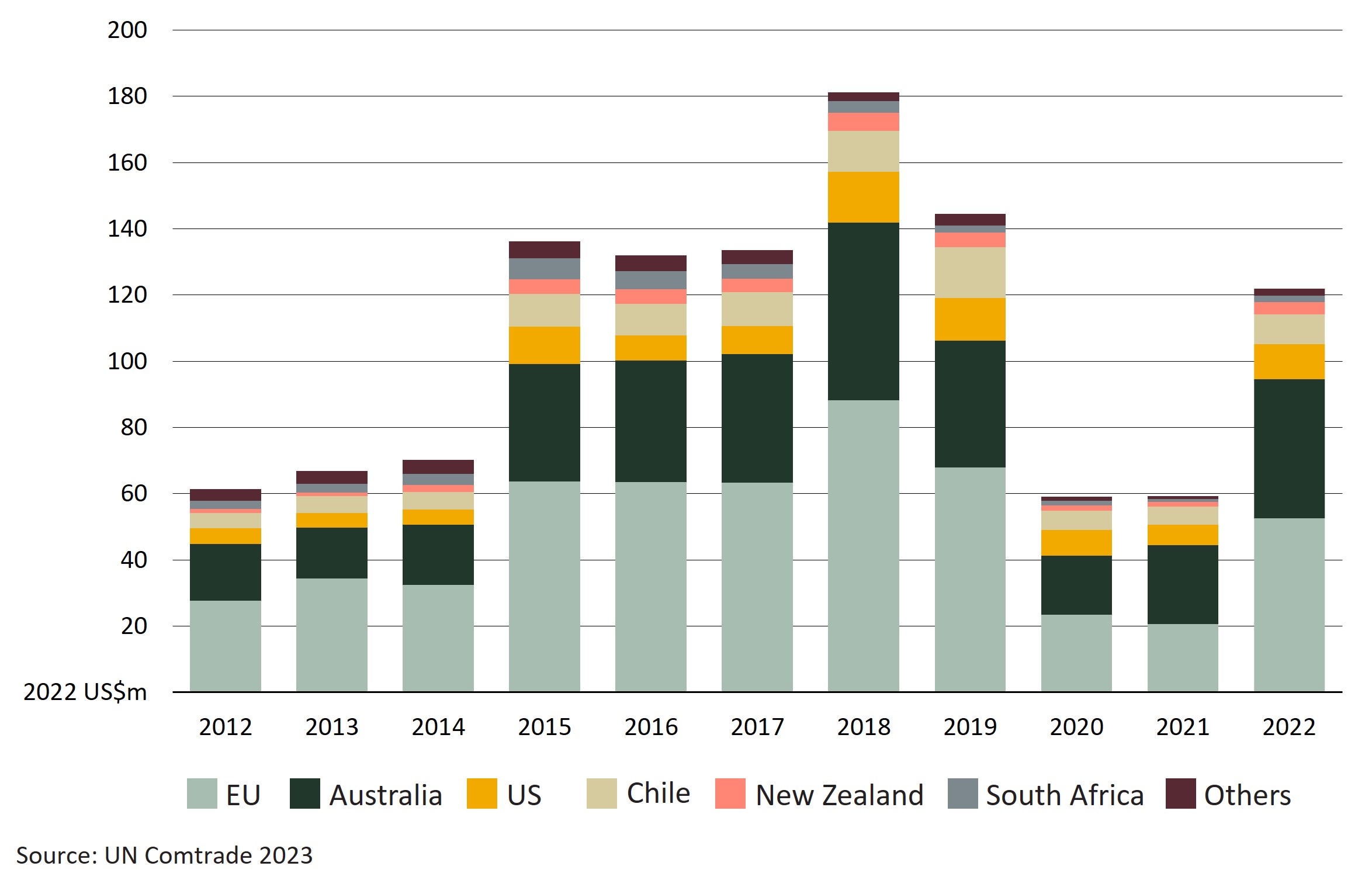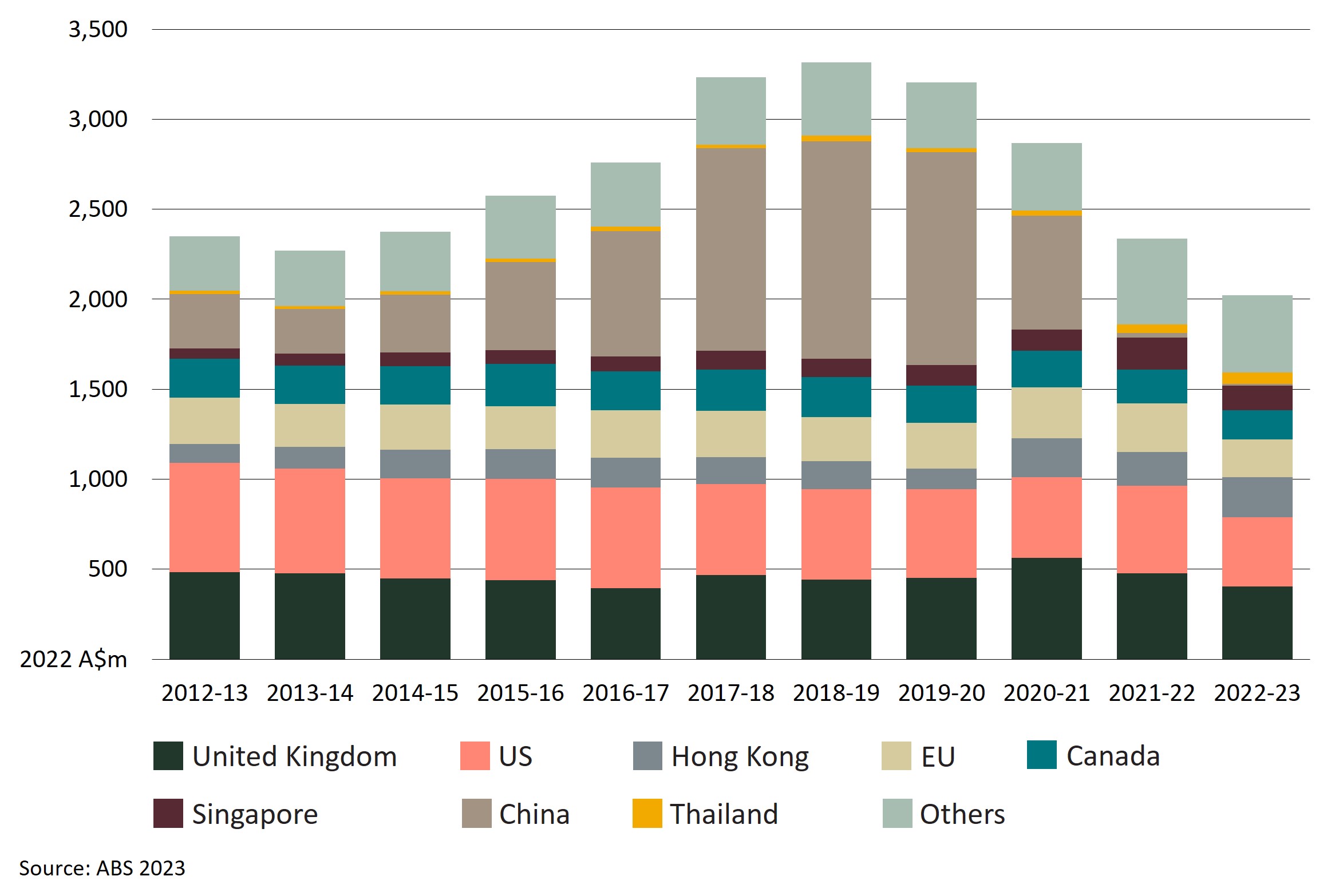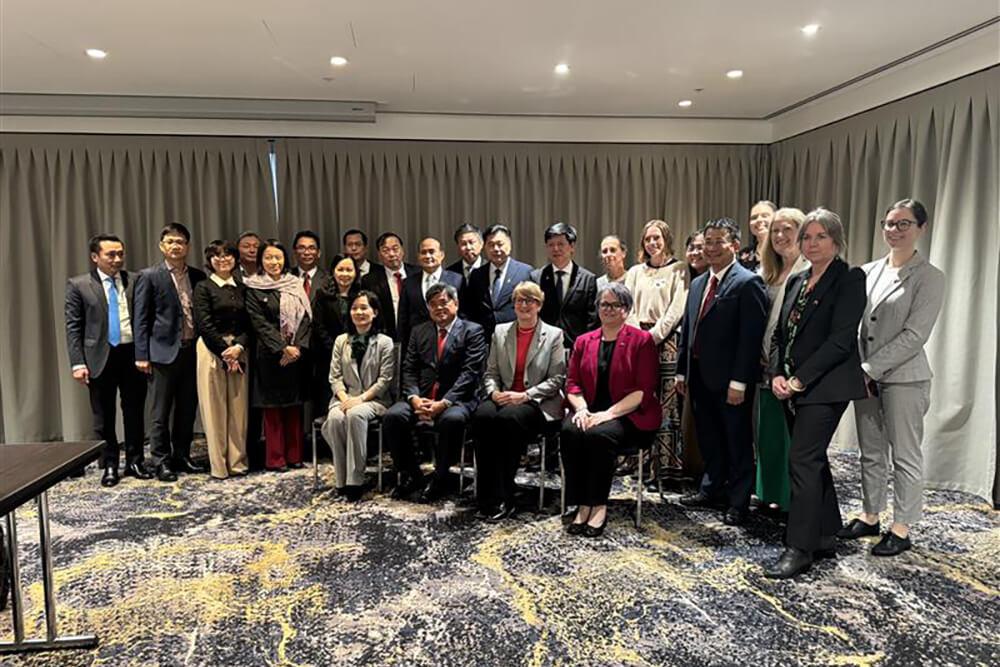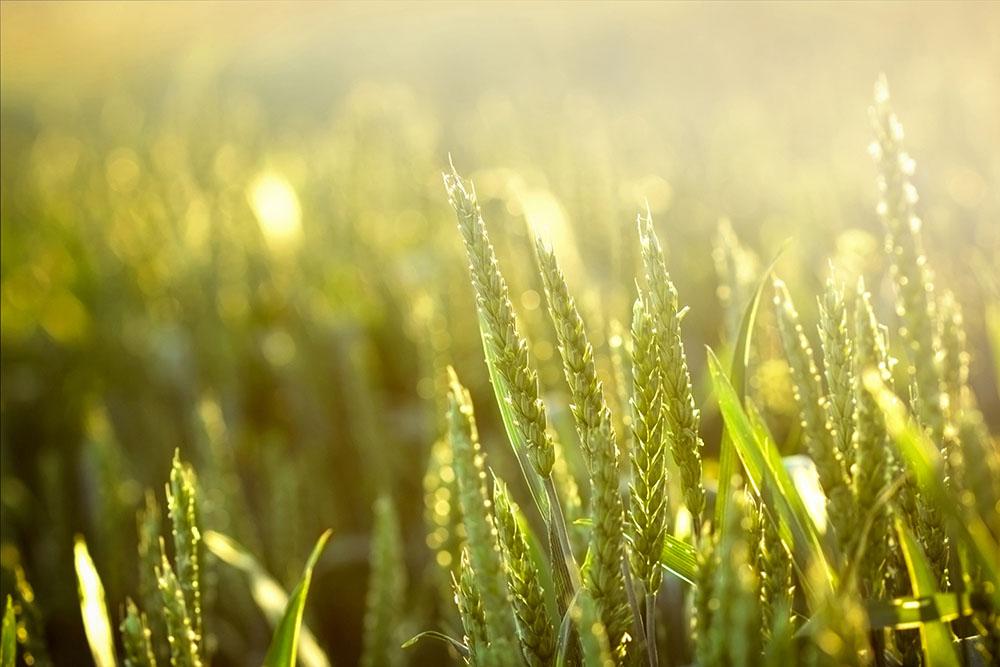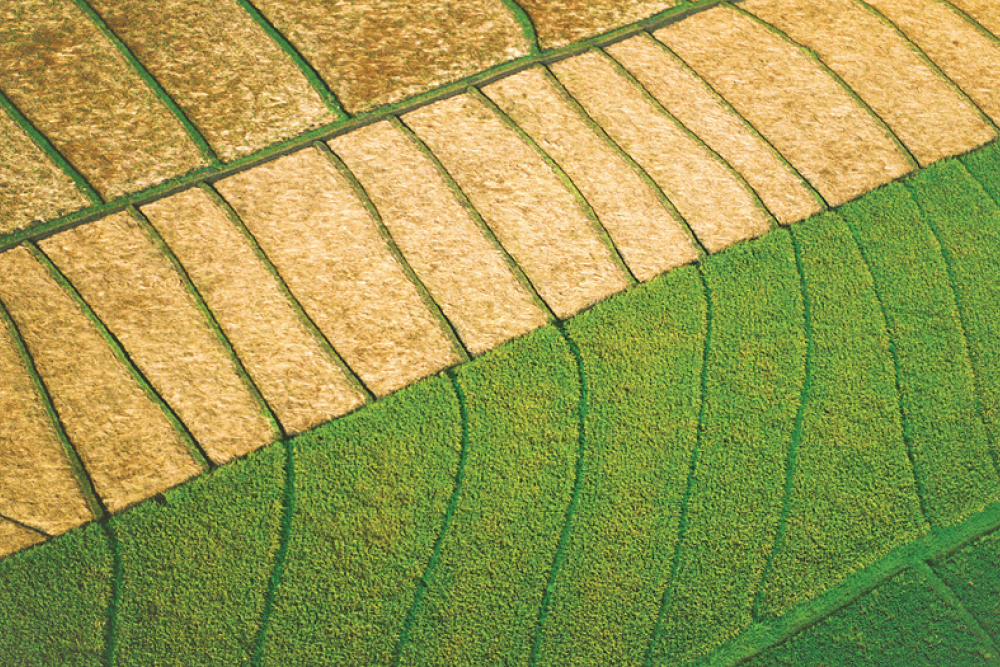On 26 October 2023, the Minister for Agriculture, Fisheries and Forestry (AFF) joined the Minister for Trade and Tourism to announce the Australian Government has negotiated better access for Australian wine exports to Thailand.
Australian wine exporters can now use the Asia-Pacific Economic Cooperation (APEC) Model Wine Certificate to certify their exports into Thailand. This simplified certification process reduces cost and administrative burden for exporters.
The Thai economy is the second largest in the Association of Southeast Asian Nations (ASEAN) and one of its fastest growing. In 2022–23, Thailand was Australia’s 7th most valuable export market for wine (or 8th largest, if the EU is counted as one), and 9th largest for AFF products overall (ABS 2023).
Implications for Australian agriculture exporters
Australian exporters can now export wine to Thailand with streamlined testing and analysis requirements, opening up opportunities to expand wine exports into this growing market. Expansion and diversification of international exports is important to offset a greater supply of domestic wine. International trade has become increasingly important for both the Australian and global wine industries. In 2022, 42% of global wine production was traded internationally compared to 22% in 2000 (WTO 2023).
Thailand and the Southeast Asia region are important trading partners. The Australian Government is investing in supporting Australian exporters to enter and expand into these markets through initiatives such as the Southeast Asia Business Exchange. The Australian Government also provided funding through the Agricultural Trade and Market Access Cooperation (ATMAC) Program to help the wine industry expand and diversify its markets.
Australian wine exports to Thailand are growing
Over the last decade, Australian wine exports to Thailand grew steadily reaching A$33 million in 2018–19 (in 2022-23 dollars) before the COVID-19 pandemic disrupted supply chains and decreased Thailand’s tourist intake (Figure 1). Despite this, Australia’s export value to Thailand only dropped to A$22 million in 2019–20 before picking up and increasing almost threefold by 2022–23.
Australia exported a record value of A$61 million of wine to Thailand in 2022–23. This was a 31% increase in value compared to 2021–22, in real terms (Figure 1). Over the past decade, red table wine has consistently been the main wine variety exported to Thailand. Its share of the trade value increased from 71% in 2012–13 to 82% in 2022–23, likely due to consumer preferences, a greater supply of red wine varietals, and redirection of exports from the Chinese market. White wine (including sparkling and table) accounted for 17% of the trade value in 2022–23, regaining value steadily over the past three years (ABS 2023). Australia’s overall production volumes of white wine varietals are predicted to rise by 27% after recovering from low levels in recent years.
Figure 1 – Value of Australia’s wine exports to Thailand by variety, 2012–13 to 2022–23
Most of Australia’s wine exports to Thailand are bottled, rather than in bulk (ABS 2023). This is due to Thailand’s import requirements. Each individual wine bottle label must be registered prior to it arriving in the country. This requires an Australian wine company planning to export to Thailand to have the product bottled and labelled before exporting, often regarded as more expensive in comparison to exporting wine in barrels or bulk.
Thailand-Australia Free Trade Agreement (TAFTA) entered into force in January 2005 and gradually reduced tariffs on Australian wine until they were eliminated entirely in 2015. Thailand also eliminated tariffs for wine imported under the plurilateral ASEAN-Australia-New Zealand Free Trade Agreement (AANZFTA) in 2020. The Most-Favoured-Nation (MFN) tariff rate for wine into Thailand is between 54-60%, meaning that Australia’s preferential tariff treatment allows greater access for Australian wine in the Thailand market (Wine Australia 2023).
TAFTA has given Australia a trade advantage over key competitor suppliers such as the EU and the US. The EU and the US do not have FTA’s with Thailand, although the EU’s trade talks with Thailand were relaunched in March this year. Chile is another competitor in the Thai market and benefits from preferential tariff treatment under the Thailand-Chile FTA. Entering into force in 2015, tariffs were immediately reduced to zero on over 90% of products traded between the two countries, including wine (USDA 2015).
Imports of wine by Thailand
Wine consumption is increasing amongst the Thai population, despite Thailand’s relatively high retail price for wine due to high local excise duties. This is driven by the country’s large tourism industry, as well as a growing interest in wine as a premium good through evolving culinary trends, particularly in pubs, restaurants, and bars (Wine Australia).
Additionally, the ASEAN region is experiencing a growing and increasingly affluent middle class, with strong economic growth and increased wealth leading to the consumption of more premium agricultural products, including wine. Wine is now regularly served at Thai social functions. Restaurants and hotels have also embraced the emerging wine culture, incorporating extensive international wine lists into their offerings (Wine Australia).
In 2022, the value of Thailand’s total wine imports was US$122 million, indicating the market is returning to its pre-COVID-19 peak of US$181 million in 2018 (Figure 2). The EU accounted for 43% of imports in 2022, with Australia the second largest supplier at 34% (UN Comtrade 2023). In the same year, the US (9%) and Chile (7%) were the other major wine suppliers for Thailand.
Figure 2 – Value of Thailand’s wine imports from the world, 2012–2022
Australia’s wine exports
Over the past three years, Australia’s wine exports have declined (Figure 3). In addition to import duties placed on wine to China, COVID-19 had an impact on the hospitality sector in most markets, challenging global demand for wine particularly for wine sold in restaurants.
Exports to Thailand, however, grew over this period. The value of exports to Thailand increased by 245% in real terms over the past decade, going from A$18 million in 2012–13 to A$61 million in 2022–23. Over the past 3 years, there was particularly strong growth with a 118% increase in the value of wine exports to Thailand.
Figure 3 – Value of Australia’s wine exports to the world by market, 2012–13 to 2022–23
The gross value of wine grape production is set to increase by 12% to A$961 million in 2023−24, recovering from unfavourable conditions in 2022−23 (ABARES 2023). Despite the increase in production, export values are expected to decrease by 6% in 2023-24 as low global prices persist. This is particularly for bulk red varieties and reflects subdued demand for wine in major consuming economies, reflecting high inflation, low disposable incomes, and changing consumer preferences. Expansion into non-traditional markets within Southeast Asia is increasingly important.
Resources
More information on Australia’s wine industry is available from Wine Australia.
The Australian Government’s network of Agriculture Counsellors provided information for this article. More information about the Agriculture Counsellor network, including contact details, are available on the Department of Agriculture, Fisheries and Forestry website.
Go further, faster with Austrade
Austrade provides information on Doing business in Thailand | Explore markets.
Thinking about expanding into Southeast Asia? Austrade’s Go Global Toolkit can help find the right market for products, identify sales partners, and understand export rules and tariffs.

